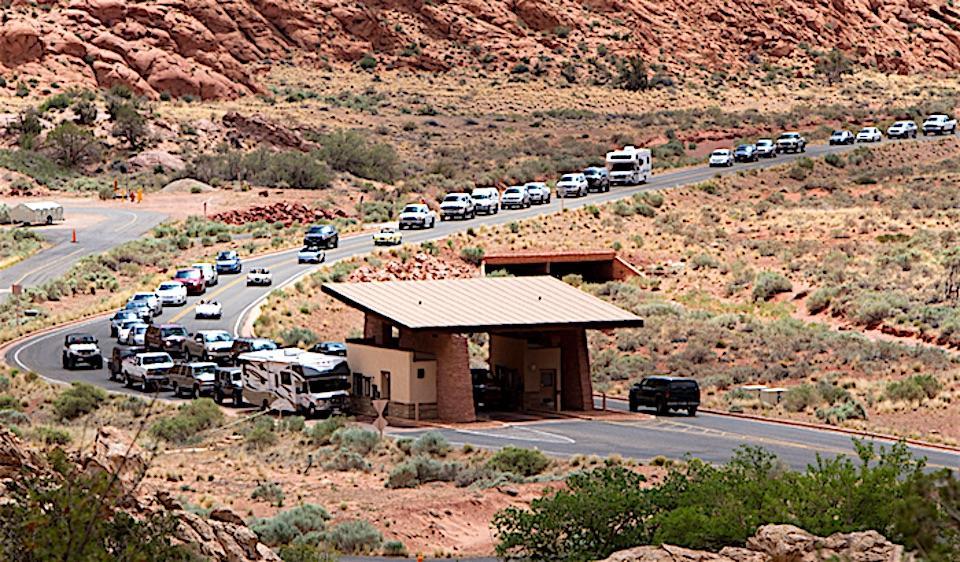
Staff at Arches National Park are returning to efforts to find a solution to the park's traffic congestion problems/NPS file
Months after a proposal to establish a reservation system for visiting Arches National Park in Utah was discarded, National Park Service staff are ready to return to discussions with the public on how best to manage traffic and congestion at the iconic park.
It was back in March when concerns that a reservation system could adversely impact the Moab area to the tune of $22 million in lost economic spending that the proposal was taken off the board. At the time, the remaining range of alternatives included a shuttle system, which previously was deemed impractical, and a secondary entrance road, something Utah's governor has suggested.
On October 15 park staff will host an hourlong public meeting at the Grand Center in Moab beginning at 5:30 p.m. to discuss efforts to further study visitor experience, transportation alternatives, and traffic patterns in the park.
Visitation to Arches National Park increased by more than 90 percent in the last 11 years. As a result, visitors face long wait times at the park’s entrance and parking lots. In 2015, the Park Service began a planning process to manage traffic congestion.
That effort, the Traffic Congestion Management Plan Environmental Assessment, outlined options, including a reservation system for entry to the park. Based on comments from the public, the Park Service canceled this environmental assessment and committed to gathering information on its traffic-management options.
“Waiting hours in line to enter the park or looking for parking are not the memories we want people to take away from their visit to Arches,” said Arches Superintendent Kate Cannon. “We want to improve access to the park, maintain a world-class visitor experience, promote safety, and protect resources. We look forward to working with the public and local leaders as we move to our next steps.”
Three years ago the Arches staff released a draft plan that proposed reservations during peak visitation months. Such a plan was needed, they said at the time, to address vehicle traffic and parking congestion problems that affect visitor access, visitor enjoyment, and resource conditions. With a very limited road system, built around the 18-mile-long main road, traffic can quickly slow to a crawl during the spring, summer, and fall seasons at the park's main attractions, such as Delicate Arch, the Windows Section, and Devils Garden.
There have been times that traffic trying to get into Arches backed up onto U.S. 191, prompting the Utah Highway Patrol to close the entrance road.
Arches is not alone in grappling with crowding issues. Yellowstone, Zion, Yosemite, Acadia, Grand Canyon, and Glacier national parks all struggle at times during the year with overcrowding. Zion officials have been working on their own management plan for some time, and it, too, includes provisions for reservations, though they might not be included in the final proposal.
Acadia earlier this year finalized its traffic management plan, which calls for a "timed-entry" reservation system, one that will give visitors a specific window to enter Acadia from mid-June to mid-October. Initially, areas requiring such reservations include the Ocean Drive corridor, Cadillac Summit Road, and the Jordan Pond North Lot. The idea is that through such a reservation system parking areas in Acadia wouldn't be overwhelmed by visitors' vehicles.



Comments
I doubt there is a management plan that is compatible both with the interests of the Park and the interests of the Moab business community. The Park needs fewer visitors, Moab wants more.
Yes; but, how can this debate about overuse possibly be happening at all when so many in the current administration and especially in the state of Utah argue that there are too many parks and too much public land already? They are all so loud and thye make so many emphatic assertions; could they really all be full of ...well, could they be incorrect?
That's true. Local business interests who are unlikely to exist without the presence of the park have a stake in growing visitation. They also have a stake in the natural beauty that is imperiled by increased visitation and the wisdom allegedly attributed to Yogi Berra that the place became so popular that nobody goes there anymore. Acadia is trying to respond to that with a plan that might encourage visitation during less popular times and seasons and to less popular sections of the park and the use of alternative forms of visitation.
Or... you can 1) stop listening to rampantly corrupt "Utah politicians" and other similarly perverted wingnuts, 2) kick out the extractive industry gangsters who use them as puppets, 3) rescind the Trump cuts to Grand Staircase - Escalante and Bears Ears National Monuments, and 4) start working to properly implement the plans that the Blanding folks were working out with Navajo stakeholders to open highly policed and regulated off pavement recreation opportunities further south toward Blanding and the reservation. This approach would have reduced the overcrowding at Arches and other places around Moab, redirected a little of the business activity toward the lower income areas around Blanding, provided jobs for that more diverse community where those jobs are actually needed, and given the BLM the opportunity to "try again" to develop and enforce regulations that would allow off pavement travel using road legal vehicles and constrained to a planned and controllable unpaved road system.